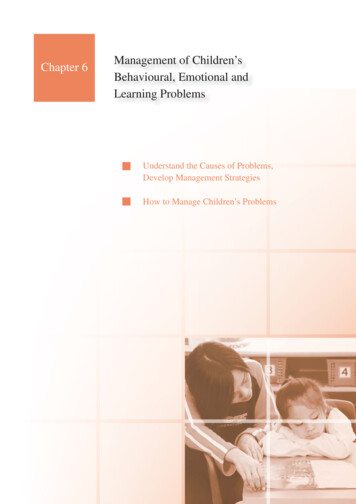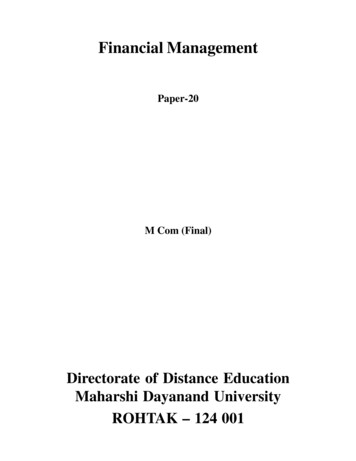
Transcription
Chapter 6Management of Children’sBehavioural, Emotional andLearning ProblemsUnderstand the Causes of Problems,Develop Management StrategiesHow to Manage Children’s Problems
Chapter 6:Management of Children’sBehavioural , Emotional andLearning ProblemsIn previous chapters, we have discussed ways of identifying children with specialneeds,their characteristics, and the basic behaviour theory and techniques. Inthis chapter, we will further put them all together to apply to the classroom settingand provide suggestions to teachers in ways of helping students with differentcharacteristics and learning needs.I. Understand the Causes of Problems, DevelopManagement StrategiesIn Chapter 3, we have mentioned that one problem can have different causes. Whena child has any learning, emotional or behavioural problems, teachers should observethe child carefully and collect information from various sources to determine whether theproblems are related to different factors “Chapter 3 : How to Identify Children with SpecialNeeds”. For example, teachers may notice a learning problem in a child who does notparticipate in class activities. The observable sign might just be the tip of an iceberg; theremay be other underlying causes (the portion of an iceberg under water), including:The child has weak cognitive and learning abilities and cannot keep up with thecurriculum, thus appearing to be inattentive in class;The child has a short attention span and has difficulty concentrating in class, thus he/she has learning problems;The child has a visual or hearing problem and thus has difficulty to understand theclass materials;The curriculum is too easy for the child, thus he/she feels bored and resulted in beinginattentive in class ;The child’s family has recently experienced a significant event which causes the childto worry, thus he/she cannot concentrate in class.BehaviouralSignNot participate in class activities(Tip of an iceberg)Weak AttentionUnderlyingCausesWeak Learning AbilityManagement of Children’sBehavioural, Emotional andLearning Problems6Visual / Hearing ImpairmentSpecific Learning DifficultiesWeak Language AbilityToo Difficult/too EasyCurriculumEmotional ProblemsNegative Family Factors66(Under water)
Let’s take the actual underlying reason for the child’s lack of participation in class in theabove example to be having weak cognitive and learning abilities. If teachers mistakethe sign for his/her having weak attention, then an unfit management strategy will beapplied and the child will not be helped effectively. Therefore, knowing only the child’sobservable behavioural signs is not enough. If a teacher has already referred the childfor an assessment and has been informed of the assessment results, he/she candevelop effective management strategies based on the professional recommendation.If referrals have not been made, the teacher will need to closely observe the childand explore various possible causes of his/her problem in order to improve the child’sperformance with suitable strategies.II. How to Manage Children’s ProblemsWhen a child has any learning, behavioural, emotional or social skills problems,teachers may try to use the following methods in the classroom. As these methodsare only suggestions, teachers should apply them with flexibility in light of their ownteaching experiences, children’s individual differences and environmental limitations.When teachers use various methods to help a child, do not forget to have frequentcommunication with the parents and explain to them why the methods are used.Then both can work together to help children learn and manage their problems moreeffectively.Refer to Chapter 6 of the DVD1. Global Learning DifficultiesChildren who have weak cognitive and learning abilities are slow to acquire new skillsand knowledge. They have difficulties adapting to new environments and acceptingnew things. They dislike challenges and tend to be more dependent. Teachers may trythe following methods for these children:i) Allowing Plenty of Time67Management of Children’sBehavioural, Emotional andLearning Problems6It is important to give children enough time tolearn and adapt. For example, teachers can givethese children an extra 10 minutes to finish classwork.
ii) Being Concise in Explanations and InstructionsTeachers should give simple, clear and brief instructions and explanations so thatthe children can master and understand easily.iii) Simplifying the TasksTeachers can simplify the tasks or divide them into smaller parts. For example,for a worksheet with 5 items, ask the children to do only 3 items; or they can beallowed to complete the worksheet at different times.iv) Increasing Level of Difficulty GraduallyThe first few items of an assignment should be easy or provided with hints, so thatchildren can master them and develop a sense of accomplishment. Then increasethe level of difficulty gradually.The level of difficulty of the assignment should be set according to the child’slearning progress.v) Giving Individual Supervision and Repeated InstructionIf there is sufficient time and staff support, teachers can givechildren instruction individually and repeatedly.vi) Arranging a BuddyFor older grades, teachers can pair up these children with a buddy who is morecompetent. They can sit together so that the buddy can provide help easily.vii) Giving Praise and EncouragementPraise and encourage children for their efforts as well as successes.Management of Children’sBehavioural, Emotional andLearning Problems62. Word Learning DifficultiesChildren with word learning difficulties usually have little problem in their generallearning. However, they are particularly weak in learning words and easily forget wordslearned. Teachers can try the following methods with these children:68
i) Teaching the Forms of Chinese CharactersWhen teaching Chinese, teachers can explain the relationship between acharacter’s form and meaning; and how the meaning of characters can sometimesbe inferred from their radicals. For example:is related to plants;is related to an action.The forms of characters can also be learned through images or stories. Forexample:(Mountain) ()(Male) Strength is used to cultivate a fieldii) Teaching Basic PhonicsWhen teaching English, teachers can use creative ways to help children rememberthe pronunciation of words. For example:The “l” in “leg” is pronounced like singing : “la la”;The “s” in “snake” is pronounced like the hissing sound of a snake: “sss”.Teachers can also teach basic phonetic rules. For example:The pronunciation of “apple” can be divided into “ap / ple”;The pronunciation of “ice-cream” can be divided into “ice / cream”.iii) Using Multi-Sensory TeachingIn general, children learn new words throughvisual and aural means. Multi-sensory teachinghelps children learn new words by stimulating theirvarious senses, such as visual, auditory (aural),tactile(touch) and kinesthetic(motion) senses.For example, teachers can ask children to write on a piece of sandpaper or sandtray (tactile), or waving their arms to write in the air (kinesthetic); at the same time,the children pronounce the word (auditory). Through multi-sensory stimulation,children’s memory of the forms of the words can be consolidated (visual).Use mnemonics such as spelling acronyms to help children remember a word:“ocean” are made up of the first letters of the words in the phrase “Old Cat’sEyes Are Narrow”. Use different colours to empasise the correct strokes of a Chinese character orsyllables of word: 「, “donkey”」69Management of Children’sBehavioural, Emotional andLearning Problems 6Teachers can also use other creative methods in teaching. For example:
iv) Developing Reading HabitChildren who have difficulties in word learning, may have moreresistance to words. Teachers can help children develop thehabit of reading and create more opportunities to introducewords to them. This will foster their familiarity and interest inwords and help them overcome their resistance to word learning.Start the children on story books with fewer words but more illustrations, thengradually move them to books with more words.Arrange the children to read with their peers or with a teacher to facilitate theirparticipation and enjoyment in reading.Remember to create a happy and relaxing reading environment without forcing thechildren to memorise words.v) Learning through GamesThe children’s interest in word learning can be enhanced through the use ofgames. Their resistance to words can be reduced as a result.The children can learn more effectively in a funful and relaxing environment.(Refer to “Appendix 6: Word Games”)3. Weak Language AbilityChildren who are weak in verbal comprehension and expression have difficultiesunderstanding long and complicated sentences. They sometimes misunderstand themeaning of questions and phrases as well. These children usually speak in simpleand short sentences, with a limited vocabulary and frequent grammatical mistakes. Inreporting events and maintaining conversations, they may be confused in expression.Because of their weak language ability, they are often unwilling to communicate withothers, which affect their social life. Therefore, teachers should pay attention to thefollowing points when communicating with these children:Management of Children’sBehavioural, Emotional andLearning Problems6i) Simplifying the SentencesTeachers can simplify their sentences while talking to the children. For example : “Weare going to have tea time soon. There are two kinds of snacks you can choosefrom. One is cake, another is sweet corn and both are delicious. Which one do youprefer?” The expression can be simplified into: “What do you want for snack, cakeor sweet corns?”.Teachers can also help the children understand better by using facial expressionsor gestures with their words.70
ii) Giving Time for Children to ExpressAllow the children to express themselves. Do not speak for them, or interrupt orrespond when they have not finished speaking.Sometimes children may not want to speak and teachers should not urge them atsuch times. Try to be patient with the children and give them more time to let themfeel that talking can be comfortable.iii) Enhancing Interest and Intention to SpeakTalk more to the children about what is happening, what they are interested inand topics about daily life to let them know that language is closely related to dailyliving.Encourage the children to express themselves even though the teacher has alreadyunderstood what they want. For example, when Sharon points to a cup of juice, theteacher can encourage her to express by asking, ‘What do you want?’ even theteacher knows what she wants.iv) Learning Language through GamesRead picture books together with the childrenand take turns with them in describing the story.Encourage the children to sing nursery rhymestogether but teaching them the lyrics is notnecessary.Play more language games to make the children find speaking is fun.(Refer to “Appendix 7: Language Games”)v) Giving Positive ResponsesListen carefully to what the children say and give non-verbal encouragement suchas a smile or nodding from time to time .71Management of Children’sBehavioural, Emotional andLearning Problems6Remember to praise and encourage the children who try to speak.
vi) Not Laughing at or Overcorrecting the ChildrenWhen the children do not express themselves clearly or are unclear in articulation,try not to laugh at or overcorrect them as it will defeat their confidence in speaking.Teachers only need to pronounce the word correctly for the children to imitate. Forexample:Teacher: (Pointing to a rabbit in a book) “Sharon, what is this?”Sharon: “Wabbit.”Teacher: “Right, this is a rabbit. What about this?”(Pointing to a banana in the book)Sharon:“Nana.”Teacher: “Right, this is a banana. What is the colour of the banana?”Lok Lok: “Yellow.”Teacher: “Correct! The banana is yellow in colour.”4. OveractivitySome children are more active than others. They often leave their seats and runaround. They have difficulty to remain seated. They are usually talkative. Theyfrequently interrupt other’s conversation and answer questions without raising theirhands. Also, they are usually more impulsive and impatient. Teachers can try thefollowing methods when dealing with these children:i) Arranging a Seat near the TeacherTeachers can have better observation and control of thebehaviours of the children if they sit near them.When a child is trying to leave his/ her seat, teachers can touchhis/ her shoulder lightly to signal the child to sit down.ii) Giving Clear and Brief InstructionsManagement of Children’sBehavioural, Emotional andLearning Problems6Because the children are usually impatient, teachers should give simple and clearinstructions to make children instantly and clearly know what they should do.Instead of giving lengthy preaching, say something like “Please keep quiet” or “Goback to your seat”.72
iii) Posting Schedules and RulesTeachers can post lesson schedules and classroom rules at a prominent placein the classroom to remind children what they should do.There should not be toomany rules. To make them easy to follow, three to four will be enough.iv) Arranging Simple TasksArrange some simple tasks for the children such as asking them to hand outschool supplies and help teachers put away materials. By doing so, the children’senergy can be diverted to more constructive activities and it can also prevent themto misbehave out of boredom.v) Changing Activities from Time to TimeIn view of the short attention span of the children, teachers can change activitieswhen needed or shift to a different teaching method. This will also give them achance to engage in more activities.vi) Giving Appropriate ResponsesWhen children behave well, teachers can praisethem or smile at them. Teachers can also rewardthe children for following rules. For example, ifthey raise their hand before answering questionsor sit quietly, teachers can reward them by puttinga stamp on their behaviour reward charts.When children misbehave, teachers can give them clear instructions to stop themisbehaviour. If they do not stop, give them consequences immediately withstrategies such as planned ignoring, logical consequence or quiet time. (Refer to“Chapter 5: Basic Behaviour Theory and Techniques” in the Manual and DVDfor the methods in modifying behaviour)73Management of Children’sBehavioural, Emotional andLearning ProblemsChildren with weak attention have difficulty concentrating in class. They are easilydistracted by external stimuli such as noises from outside or birds flying by thewindow. It is not easy for them to sustain their attention in an activity and they maynot pay attention when talking with others. They are often careless, making carelessmistakes in their work, appearing forgetful and often lose their belongings. They aredisorganised and often place their belongings here and there. Teachers may use thefollowing methods with these children:65. Weak Attention
i) Arranging Seats Away from Doors and WindowsAsk the children to sit away from doors and windows to reduce external distractions.ii) Calling out Their Names or Asking Them QuestionsWhen teachers notice that the children are getting distracted,call them by name and ask them questions more often to ensurethat they are paying attention in class.iii) Maintaining Eye ContactsWhen talking to the children, maintain eye contacts. Teachers may tap their armsto get their attention.iv) Asking Children to Repeat InstructionsTo ensure that the children are listening and understand what they need to do,teachers can ask them to repeat the instructions they were given.v) Using Interesting Teaching MaterialsUse novel and interesting materials to engage the children’s attention in class.vi) Changing Activities from Time to TimeChange activities or teaching methods from time to time to avoid the childrenlosing their concentration after a period of time.vii) Arranging a BuddyManagement of Children’sBehavioural, Emotional andLearning Problems6For older grades, teachers may ask children with better attentioncontrol to sit next to these children to remind them to payattention in class or to provide assistance in class work.74
6. TantrumsSome children have relatively poor emotion control and will throw tantrums easily.There are many reasons why children go into a tantrum. Examples are: children whotend to be self-centred will express their frustration by throwing tantrums when theirneeds are not met; some may use tantrums to get attention; some who cannot expressthemselves well or feel that they are misunderstood may lose their temper; and thereare some children who are always rebellious and refuse to cooperate with adults tendto make a scene over trivial matters. Therefore, when dealing with children’s emotionalproblems, teachers should first understand the reasons why children have a tantrum inorder to handle them effectively.Teachers may use the following methods for children with weak emotion control:i) Setting RulesSet rules with the children to let them knowteachers’ expectations and understand thatthrowing tantrums is an unacceptable behaviour.Explain to children in advance the consequencesof throwing tantrums.ii) Increasing CommunicationTalk with the children more often. Try to understand the reasons behind theirfrequent tantrums by listening to their thoughts and feelings.iii) Showing Them Ways to Express FeelingsSome children may throw tantrums because they do not know how to expresstheir feelings. Teaching them the appropriate ways may reduce the chance of theirtantrums.Teach the children the “feeling words” e.g., “You shouldn’t throw things when youare in frustration. Instead, you can say ‘I am angry’ and tell me why.”Praise them when they do share things or compromising their wants with others.75Management of Children’sBehavioural, Emotional andLearning ProblemsWhen dealing with children who tend to be selfcentred, teachers may instill the concept of sharingand compromising.6iv) Instilling the Concepts of Sharing andCompromising
v) Giving Appropriate ResponsesIf children oppose to and refuse to cooperate with teachers intentionally, teachersmay ignore such behaviour. Do not pay attention to them. Apply other methodssuch as logical consequence, quiet time or time-out when necessary.Teachers should praise and pay more positive attention to children when theybehave well.(Refer to “Chapter 5 : Basic Behaviour Theory and Techniques” in Manual andDVD)Teachers may follow the steps below in handling children who are screaming andthrowing a tantrum:1. Get the child’s attentionApproach the child and call his/hername to get his/her attention2. Give instructionsAsk the child to stop the tantrum,e.g., “Please stop screaming.”The child is willing to cooperateOrThe child refuses to cooperateManagement of Children’sBehavioural, Emotional andLearning Problems63. Praise the child3. Handle the child’s tantrumWhen the child does as you ask,praise the child, “Thanks forstopping your screaming when Iasked you to.”If the child continues to throw tantrums,decide on a strategy to handle. Tell thechild what he/she has done wrong and theconsequence, “You are not stopping yourscreaming. Now go to time-out.”4. Understand the reason for the tantrum(Refer to Chapter 5 on how to applytime-out)When time-out is over and the childhas calmed down, talked with him/herabout the reasons for the tantrum.Show him/her the proper ways toexpress feelings.76
7. Other Emotional ProblemsBesides tantrums, children may have other emotional problems, such as being anxiousor feeling depressed.AnxiousnessSome children get anxious easily. Their anxiousness is more than being shy. Whentalking to others or answering questions, they may be at a loss and gets fidgety. Inmore serious cases, they may refuse to participate in class activities or even refuse togo to school.Depressed MoodChildren who are feeling depressed looked alwayssad. They show no interest in class activities andgames and are unwilling to talk with people. Theyeasily cry or lose their temper.Teachers may use the following methods with childrenhaving emotional problems:i) Listening to the Children’s Thoughts and FeelingsTalk to these children more often to understand what they think and feel. As theymay be unwilling to talk right away, teachers should be patient with them and makerepeated attempts.ii) Observing and Describing Their FeelingsObserve the children’s behaviour closely andidentify their emotions. Try to describe theirfeelings. When the children feel that they are beingunderstood, they will be more willing to share theirthoughts with you. Teachers may say,77Management of Children’sBehavioural, Emotional andLearning Problems“Are you feeling a little nervous so that you don’t want to tell stories in front ofothers?”6“I can tell you are a little upset. Will you tell me what’s happened?”
iii) Using Toys or Drawing to AidChildren are usually more relaxed and easier for them toexpress their feelings when playing games or drawing.For those children who are unwilling to express themselves,teachers may change to a more relaxed environment, such asthe play room or family corner, and try to start the conversationwith the aid of puppets, toys or drawing.iv) Allowing Time with EncouragementIf children do not want to participate in an activity or are not willing to speak, do notpush them. Instead, give them more time and be patient with them. Let them jointhe activity when they feel comfortable to do so.v) Understanding Their Current SituationPay attention to any events happened in school or at home that would possiblyaffect the children and lead to their emotional problems.8. Weak Social SkillsSome children have weak social skills. They do not like to interact with people.They often prefer to be on their own and play alone. Rarely would they initiate tocommunicate or share with others. They avoid eye contacts and are hardly able tonotice others’ needs and feelings. They do not know how to get along with people. Itis hard for them to start or hold a conversation, and sometimes they even say or dosomething inappropriate. Teachers may try the following methods with these children:i) Encourage Children to Participate in Social ActivitiesManagement of Children’sBehavioural, Emotional andLearning Problems6Using the activities they find interesting to encourage thechildren to take part in social activities. For instance, if a childlikes to play with toy cars, teachers may encourage him/her toplay with toy cars in a group.At first, the children may need teachers to stay by their sideto guide them in interacting with others. Teachers may gradually get less involvedafter the children begin to mix with others.78
ii) Encouraging Others to Approach theChildrenTeachers may ask a few more outgoing childrento approach these children, e.g. inviting them toactivities such as reading books or playing in thefamily corner together.iii) Demonstrating Social Communication SkillsTeachers may demonstrate the appropriate social communication skills to them ifthe children speak or act inappropriately. For example:“If you see teachers or classmates in the morning, you may say ‘Good morning’, oryou can nod your head and smile to them.”“If you want to play with others, you may say to them, ‘I want to play with you’instead of hugging and kissing them.”Practise such skills with the children frequently so that they can be familiarized withthe skills gradually.iv) Creating Opportunities for CommunicationThe children may not have intention to communicate with others. Sometimes,teachers can create chances for them to express themselves. For instance,teachers might have already figured out from their behaviour that they want moresnacks. Teachers may take this opportunity to encourage them to ask for thesnacks before giving them.v) Encouraging Eye ContactsRemind the children to look at others when theyare talking.Whenever the children are looking at you, givethem a smile. They will eventually understand thatmaintaining eye contacts will result in a positiveresponse.79Management of Children’sBehavioural, Emotional andLearning ProblemsIf the children do not want to join in activities, do not push them. Teachers shouldgive them more time to participate when they are ready.6vi) Allowing Time with Encouragement
9. Difficulty in Adapting to ChangesSome children find it hard to cope with changes, such as changes in activities and theenvironment. Teachers may consider the following handling methods:i) Using Visual or Spatial PromptsTeachers can enhance children’s understanding of the flow ofactivities by using picture cards or posting classroom rules anddaily schedules.ii) Using Verbal or Gesture PromptsTeachers may tell the children before they change classrooms or activities, so thatthey are better prepared.When changing to the next activity, teachers may give verbal instructions orgesture cues to assist the children.iii) Maintaining Routines, Avoiding Sudden ChangesManagement of Children’sBehavioural, Emotional andLearning Problems6The daily routines must be consistent and follow through to make sure that thechildren can follow. Avoid frequent changes.80
Management of Children's Behavioural, Emotional and Learning Problems 66 Chapter 6: Management of Children's Behavioural , Emotional and Learning Problems In previous chapters, we have discussed ways of identifying children with special needs,their characteristics, and the basic behaviour theory and techniques. In










